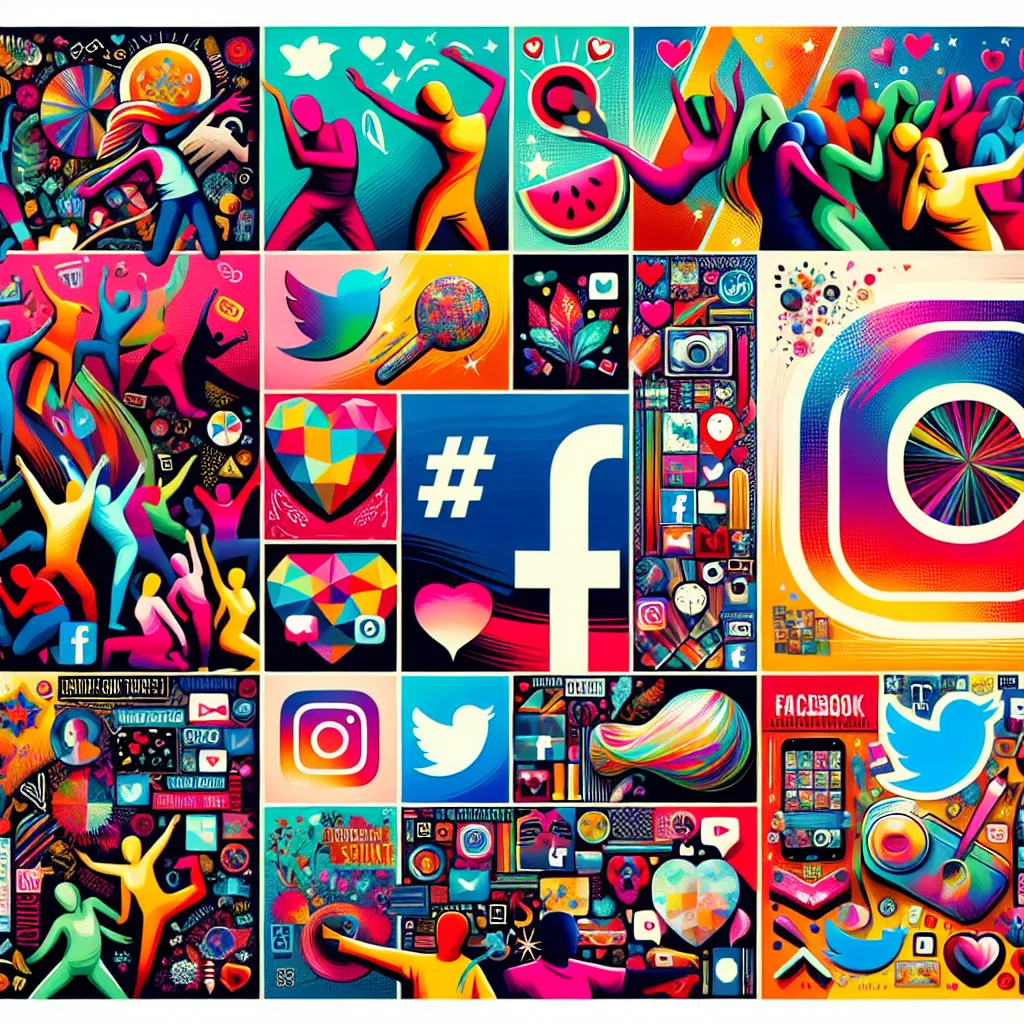As an experienced IELTS examiner, I’ve noticed that questions about social media trends are becoming increasingly common in the Speaking test. This topic allows examiners to assess candidates’ ability to discuss contemporary issues and express personal experiences. Let’s explore how to excel in answering questions about recent social media trends you’ve participated in.
Nội dung bài viết
 Social Media Trends Collage
Social Media Trends Collage
Part 1: Introduction and Interview
In this section, the examiner may ask general questions about social media and trends. Here are some common questions you might encounter:
- Do you use social media often?
- What’s your favorite social media platform?
- Have you noticed any interesting trends on social media recently?
- How do you think social media trends affect people’s behavior?
Let’s look at a sample answer for the third question:
Examiner: Have you noticed any interesting trends on social media recently?
Sample Answer (Band 7-8):
“Yes, I’ve noticed several interesting trends lately. One that caught my attention was the ’10-year challenge’ on Facebook and Instagram. People were posting side-by-side photos of themselves from 2009 and 2019 to show how they’ve changed over a decade. It was fascinating to see the transformations and reflect on how quickly time passes.”
Sample Answer (Band 8-9):
“Absolutely, social media is a hotbed of trends these days. Recently, I’ve been intrigued by the rise of ‘TikTok challenges.’ These often involve people performing choreographed dances or completing specific tasks, which then go viral as others replicate them. What I find particularly compelling about this trend is how it bridges generational gaps, with people of all ages participating and sharing their interpretations. It’s a testament to the unifying power of social media in creating shared experiences.”
Part 2: Long Turn
Here’s a potential cue card related to the topic:
Describe a recent social media trend that you participated in
You should say:
- What the trend was
- How you found out about it
- Why you decided to participate
- And explain how you felt about the experience
Remember, you have one minute to prepare and should aim to speak for 1-2 minutes.
Sample Answer (Band 7-8):
“I’d like to talk about a recent social media trend I participated in called the ‘Ice Bucket Challenge.’ This trend went viral a few years ago on various social media platforms, especially Facebook and Instagram.
I first came across the Ice Bucket Challenge when I saw several of my friends posting videos of themselves dumping buckets of ice water over their heads. It piqued my curiosity, so I did some research and discovered that it was a campaign to raise awareness and funds for ALS, also known as Lou Gehrig’s disease.
I decided to participate because I thought it was a creative way to support a good cause. Also, many of my friends had nominated me in their videos, so I felt a bit of friendly pressure to join in.
The experience was both exhilarating and shocking. When the ice-cold water hit me, it literally took my breath away! But it was also fun to be part of something bigger than myself. I felt a sense of community and connection with others around the world who were also participating.
Overall, I found the experience to be positive and meaningful. It opened my eyes to a disease I knew little about before, and I was glad to contribute to raising awareness. Plus, it was entertaining to watch my friends’ reactions in their videos and to create my own.”
Sample Answer (Band 8-9):
“I’d like to discuss my participation in the ‘Plank for a Purpose’ challenge, a recent social media trend that took the fitness community by storm. This challenge involved individuals holding a plank position for as long as possible, documenting their time, and then donating a corresponding amount to a charity of their choice.
I first stumbled upon this trend while scrolling through my Instagram feed. A fitness influencer I follow had posted a video of herself planking for an impressive five minutes, accompanied by a heartfelt caption about the importance of combining physical health with social responsibility.
The concept resonated deeply with me for several reasons. Firstly, as someone who’s passionate about fitness, I saw it as an opportunity to push my physical limits. Secondly, the charitable aspect aligned perfectly with my belief in giving back to the community. Lastly, I was intrigued by the idea of leveraging social media for a positive cause, countering the notion that these platforms are solely for self-promotion.
Participating in the challenge was an eye-opening experience. The physical aspect was more demanding than I had anticipated, testing not just my core strength but also my mental resilience. As I held the plank position, fighting against the burning sensation in my muscles, I found myself reflecting on the struggles faced by those who would benefit from the donations.
The social aspect of the challenge was equally impactful. Sharing my video online fostered a sense of community, as friends and followers cheered me on and even pledged to match my donation. It sparked conversations about fitness and philanthropy, creating a ripple effect of positivity in my social circle.
In retrospect, this experience reinforced my belief in the power of social media to mobilize people for a common good. It demonstrated how a simple action, when multiplied across thousands of participants, can make a tangible difference. Moreover, it served as a reminder that personal growth and social responsibility can go hand in hand, creating a win-win situation for all involved.”
Follow-up Questions
- Do you think social media trends have a lasting impact?
- How do social media trends differ from traditional forms of activism?
- Can you think of any potential drawbacks to participating in social media trends?
Sample Answer for Question 1 (Band 8-9):
“The lasting impact of social media trends is a nuanced topic. While many trends are ephemeral by nature, some can indeed have enduring effects. Take the #MeToo movement, for instance. What started as a hashtag evolved into a global conversation about sexual harassment and assault, leading to tangible changes in policies and public discourse.
However, the longevity of a trend’s impact often depends on several factors. Firstly, the gravity of the issue it addresses – trends tackling serious social or environmental problems are more likely to leave a lasting imprint. Secondly, the level of engagement it generates – if a trend manages to mobilize a significant number of people, it’s more likely to translate into real-world action.
That being said, even seemingly trivial trends can have unexpected long-term effects. For example, the ‘Ice Bucket Challenge’ I mentioned earlier not only raised awareness about ALS but also generated substantial funding for research, potentially contributing to future medical breakthroughs.
In essence, while not all social media trends have lasting impacts, they do have the potential to spark important conversations, shift public opinion, and occasionally, instigate meaningful change. The key lies in harnessing the viral nature of these trends to spotlight important issues and channel the collective energy towards constructive outcomes.”
Part 3: Two-way Discussion
Examiner: How do you think social media trends influence young people’s behavior?
Sample Answer (Band 7-8):
“I believe social media trends have a significant impact on young people’s behavior. They often shape fashion choices, influence language and slang, and even affect social norms. For example, dance challenges on TikTok have become incredibly popular, leading many young people to learn and perform these dances in real life. This can be both positive and negative. On one hand, it encourages creativity and physical activity, but on the other, it might promote a culture of seeking validation through likes and shares.”
Sample Answer (Band 8-9):
“The influence of social media trends on young people’s behavior is multifaceted and profound. These trends serve as powerful catalysts, shaping not just superficial aspects like fashion or language, but also molding perceptions, values, and social interactions.
On a positive note, social media trends can foster a sense of global community among youth. They can raise awareness about important issues, promoting social responsibility and activism. For instance, the climate strike movement, largely propelled by social media, has mobilized millions of young people worldwide to take action on climate change.
However, there’s also a flip side to consider. The viral nature of these trends can sometimes lead to risky behavior, as seen with challenges like the ‘Tide Pod Challenge’. Moreover, the constant exposure to carefully curated content can exacerbate issues related to body image and self-esteem.
It’s also worth noting that social media trends can create a ‘fear of missing out’ or FOMO, potentially leading to increased screen time and decreased face-to-face interactions. This shift in social dynamics could have long-term implications for interpersonal skills and mental health.
Ultimately, while social media trends undeniably wield significant influence over young people’s behavior, it’s crucial to approach this phenomenon with a balanced perspective. Educating youth about digital literacy and critical thinking can help them navigate this landscape more responsibly, harnessing the positive aspects of these trends while mitigating potential risks.”
Key Vocabulary and Phrases for High Scores
-
Go viral /ɡəʊ ˈvaɪrəl/ (phrasal verb): To spread quickly and widely on the internet.
Example: “The dance challenge went viral overnight, with millions of users participating.” -
Pique one’s curiosity /piːk wʌnz ˌkjʊəriˈɒsəti/ (idiom): To arouse someone’s interest or curiosity.
Example: “The unusual hashtag piqued my curiosity, prompting me to investigate further.” -
Exhilarating /ɪɡˈzɪləreɪtɪŋ/ (adjective): Extremely exciting and enjoyable.
Example: “Participating in the viral challenge was an exhilarating experience.” -
Resonate /ˈrezəneɪt/ (verb): To evoke a feeling of shared emotion or belief.
Example: “The social media campaign resonated with young people, leading to widespread participation.” -
Mobilize /ˈməʊbəlaɪz/ (verb): To organize or prepare for action.
Example: “Social media has the power to mobilize people for various causes.” -
Ephemeral /ɪˈfemərəl/ (adjective): Lasting for a very short time.
Example: “Many social media trends are ephemeral, fading away as quickly as they appeared.” -
Nuanced /ˈnjuːɑːnst/ (adjective): Characterized by subtle shades of meaning or expression.
Example: “The impact of social media trends on society is a nuanced topic that requires careful analysis.”
Examiner’s Advice
To achieve a high score in the IELTS Speaking test when discussing social media trends:
-
Demonstrate awareness: Show that you’re familiar with current trends and can discuss them intelligently.
-
Use varied vocabulary: Incorporate a range of words and phrases related to social media and trends.
-
Provide personal insights: Don’t just describe trends; share your thoughts and experiences with them.
-
Discuss implications: Consider the broader impact of social media trends on society, culture, or behavior.
-
Practice fluency: Work on speaking smoothly and confidently about these topics.
-
Develop critical thinking: Be prepared to analyze trends from different perspectives.
Remember, the key to success in the IELTS Speaking test is not just about knowing the topic, but about expressing your ideas clearly, fluently, and with a rich vocabulary. Good luck with your preparation!
For more tips on improving your IELTS Speaking skills, you might find our article on describing a time when you explored a new interest or hobby online helpful. It provides additional strategies for discussing online experiences effectively.


